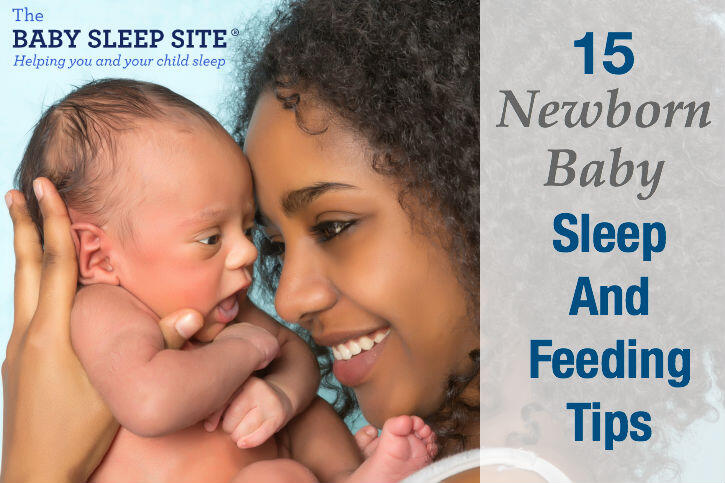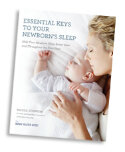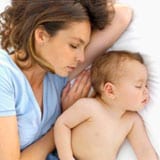
Newborn babies are so wonderful, aren’t they? They’re all soft, new skin
and sweet-smelling heads and tiny, adorable features. I remember each
one of my children as newborns, and each of them just broke my heart
with their cuteness when they were tiny.
But caring for a newborn? Trying to figure out feedings and naps and
swaddling and all the things that go along with parenting a new baby?
That usually doesn’t feel so wonderful. In fact, if you’re a new parent, it may feel totally overwhelming!
Whether you’re a brand-new, first-time parent who’s completely
befuddled by your baby, or whether you’re a “seasoned veteran” parent
who’s expecting another baby and just needs a refresher course in
newborn care – we can help. Keep reading for our top 15 newborn baby
sleep and feeding tips! (And don’t forget, you can download our newborn
free guide,
15 Baby Sleep Facts New Parents Need To Know!)
15 Newborn Baby Sleep and Feeding Tips
1. Swaddle Your Newborn Full disclosure: swaddling
is generally a great way to help newborns sleep longer and more soundly,
but not all babies like to be swaddled. You may need to try different
swaddling techniques, until you find one that works with your baby’s
temperament – or, you may need to scrap swaddling altogether! Of course,
whatever you do, remember that safety comes first, with swaddling –
never put a swaddled baby face-down in the crib, never co-sleep with a
swaddled baby, and make sure that your swaddle is tight enough that the
blankets won’t come loose, but not so tight that it interferes with hip
movement or breathing.
2. Wear Your Newborn Baby Baby-wearing – when done
safely – is a fantastic way to not only bond with your baby, but to also
improve sleep. Even the fussiest, most colicky babies generally calm
down when held snugly against mom or dad’s body! Wearing your baby can
also be a great way to deal with reflux symptoms. (Keep reading for more
info about reflux.)
3. Your Newborn Baby’s Colic If your baby is fussy all the time and just won’t settle, you may wonder if
colic
is to blame. It’s important to remember that periods of crying are
normal in the newborn stage. But if that crying is intense and lasts for
hours on end, then you may be dealing with colic.
4. Newborn Baby Fussiness It’s important to remember
that not all fussiness is due to colic. It’s normal for newborns to
have fussy spells – and fussy times of day, for that matter. In fact,
many newborns are fussy in later afternoon and early evening. This is
generally referred to as
“The Witching Hour”.
5. Room-Sharing and Co-Sleeping With Your Newborn Baby
Many of us in the western world have been conditioned to believe that
babies sleep in cribs, alone, in a separate room. And while that
sleeping arrangement may work just fine for some families, many other
families find that the inconvenience of having to walk down the hall for
every night feeding and diaper change is more trouble than it’s worth.
Room-sharing can be a great solution – simply sleep your newborn near
your bed in a portable crib or bassinet. You can even use a product like
the Arm’s Reach Co-Sleeper if you want to make nighttime nursing easy.
Co-sleeping is a popular option for many families, too, since it makes
breastfeeding super easy at night. Just be aware that co-sleeping
absolutely must be done safely, if you intend to co-sleep with your
newborn.
6. Your Newborn Baby’s Routine Gentle but consistent
daily routines are GREAT for encouraging better sleep. The
Eat-Sleep-Play routine (or the E.A.S.Y. routine, if you’re a Baby
Whisperer fan) is great for newborns, as it helps gently guide sleep and
feeding times. Remember, your routines don’t need to be driven by the
clock – instead, use your baby’s sleep and feeding cues to shape your
routines.
7. Newborn Baby Massage A bath may not be the most relaxing activity you can do with your baby, but baby massage is a VERY relaxing activity!
Baby massage has been shown to help babies (and parents!) relax, and to promote better sleep.
8. Fresh Air and Sunlight What do fresh air and
sunshine have to do with sleep? Plenty, actually. Did you know that
exposing your baby to sunlight can go a long way towards helping re-set
her circadian rhythms and to correct day/night confusion? It can – more
on that in a moment! And fresh air helps, too – studies show that a
daily dose of fresh air (like the kind you’d get from a brisk, 20 minute
walk) really does help babies sleep better and longer.
9. Your Newborn Baby’s Day/Night Confusion Babies
don’t spring from the womb understanding the difference between night
and day – in fact, many newborns have their days and nights completely
mixed up! If your baby sleeps all day and is up all night, you can take
steps to correct this day/night confusion. Try feeding and playing with
your baby in a brightly-lit room during the day, and then keep the room
very dark and your interactions minimal at night.
10. Newborn Baby Awake Time Speaking of day/night
confusion – one way to help your newborn sort out days and nights is to
keep your baby awake for a short time between daytime feedings. However,
be sure that your newborn’s wake time is on the short side – aim for 45
minutes or so in the first 6 weeks after birth.
11. Growth Spurts Your baby will go through many
growth spurts in the first year of life, but a number of those happen
during the newborn stage. It’s key to know approximately when these
growth spurts will happen; it’s also key to feed your baby often during
these times. It may feel like all your baby does is eat and sleep during
a growth spurt, but that’s normal! You can read more about
newborn growth spurts here.
12. Reflux Many babies spit up occasionally, but
true reflux is something altogether worse – burning stomach acid and
constant vomiting make sleep almost impossible! Fortunately, there are
ways you can treat reflux at home, and can work to help your newborn
sleep better even when reflux symptoms are bad. Read more about
newborn reflux here.
13. Breastfeeding Breastfeeding is a great way to
feed your baby, but many new moms find that breastfeeding is tougher
than they’d anticipated. But you really can b
reastfeed your baby AND work towards better, longer sleep!
14. Sleep Associations Many of the strategies and
techniques you will use to help your newborn sleep in the early weeks
and months after birth may very well become negative
sleep associations.
If you rock or hold or swing or feed your newborn to sleep, pretty
soon, she’ll NEED you to do those things at nap time and bedtime – and
each time she wakes early. Sleep coaching is simply the process of
gently helping your baby learn a new way to sleep – one that doesn’t
involve you. However, don’t let the fact that your newborn may form
sleep associations make you nervous – we usually recommend that you do
whatever you have to do to help your baby sleep in the first two months
or so after birth. Then, once you feel comfortable and your baby seems
ready, you can slowly begin working towards more independent sleep. For
instance, you can try putting your baby down slightly awake for the
first morning nap – that’s a step in the right direction.
15. 3/4 Month Sleep Regression Why are we including a link to the
4 month regression
in a newborn-focused article? Simple – this is the first big sleep
regression a baby goes through, and it usually jumps up and bites
parents in the backsides, in our experience! Most parents are floored by
this regression – just as they get baby sleeping well at night and
napping better, BAM. Baby is fussy as all get out, sleep falls apart,
and mom and dad are left wondering what on earth happened. But don’t
worry – we’ve helped thousands of parents with this sleep regression, so
we know a thing or two about it!
Newborn Sleep Help That Works – Guaranteed!
Being the parent of a newborn is simultaneously the most difficult
and the most wonderful thing on earth, isn’t it? But all of us at The
Baby Sleep Site
® know first-hand how exhausting and
overwhelming it can be to try and help your newborn sleep well. Yes,
newborns are supposed to wake around the clock for feeds, but that
doesn’t mean you can’t gently encourage better, deeper sleep from your
baby. And we can help with that! Connect with a consultant today, and
she will craft a newborn-focused Personalized Sleep Plan™ specifically
for your baby, that aligns with your unique situation and challenges,
and with your parenting goals.
Browse our list of consultation package options here.
Once you make your choice and purchase, you will immediately receive
an e-mail with your Helpdesk login information. You’ll be able to log in
and get started immediately!
Want more information about how personalized help works?
Check out our FAQ page here, and get answers. You can also
take a tour of the Helpdesk.
Have sleep or feeding questions about your newborn? Ask, and we’ll answer!

Essential Keys to Your Newborn’s Sleep is THE newborn sleep book that
will help you to not only improve your newborn’s sleep using gentle,
sleep-inducing routines – it will also answer your feeding and newborn
care questions. You can even buy a bundle package that includes the
e-book AND a Personalized Sleep Plan™ PLUS a follow-up email to use for
further support!

Or, join our
Members Area
packed with exclusive content and resources: e-Books, assessments,
detailed case studies, expert advice, peer support, and more. It
actually costs less to join than buying products separately! As a
member, you’ll also enjoy a weekly chat with an expert sleep consultant.
And the best part –
members receive 20% off all sleep consultation services!
Can’t decide which product or service is right for you? Visit our Getting Started Page for help.















l am now at a loss on what to do about his hyperactivity and especially in the evening.
Help me please!